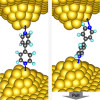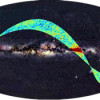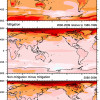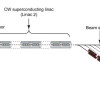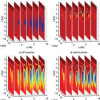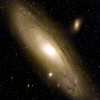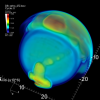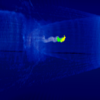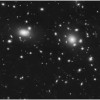Science News
NERSC Helps Researchers Discover a Potential On-Off Switch for Nanoelectronics
Researchers at the Lawrence Berkeley National Laboratory's (Berkeley Lab) Molecular Foundry and Columbia University found that electrical resistance through a molecular junction—a nanometer scale circuit element consisting of a single molecule contacted with gold wires—can be turned on and off by simply pushing and pulling the junction. Experts believe that this newly demonstrated molecular-scale control could be leveraged for future nanoscale electronic devices. Read More »
NERSC Continues Tradition of Cosmic Microwave Background Data Analysis with the Planck Cluster
More than 95 percent of our universe is made up of mysteriously "dark" materials—approximately 22 percent of it is comprised of invisible dark matter, while another 73 percent is posited to be dark energy, the force that is accelerating universal expansion. Armed with a new spacecraft called Planck and supercomputers at the Department of Energy's (DOE) National Energy Research Scientific Computing Center (NERSC), astronomers around the world hope to make tremendous strides toward illuminating the nature and origins of these mystifying materials by creating high-resolution maps of extremely subtle variations in the temperature and polarization of the Cosmic Microwave Background (CMB), which is leftover light from the Big Bang that permeates the universe. Read More »
It's Not Too Late to Change Global Warming's Course
The threat of global warming can still be greatly diminished if nations cut emissions of heat-trapping greenhouse gases by 70 percent this century, according to a study led by scientists at the National Center for Atmospheric Research (NCAR). While global temperatures would rise, the most dangerous potential aspects of climate change, including massive losses of Arctic sea ice and permafrost and significant sea level rise, could be partially avoided. Read More »
Lasers without Mirrors, Designed by Supercomputer
Sometimes it takes a big machine to understand the tiniest details. That’s the case with free electron lasers (FELs). FELs have the potential to address a host of research challenges in physics, chemistry and material and biological sciences. Read More »
NERSC Contributes to EMGeo Mapping Software for Finding Hidden Oil and Gas Reserves
As the world's demand for energy increases, billions of dollars are dedicated to the search for deep-water hydrocarbon reservoirs each year. Although seismic imaging methods have long been used to collect valuable information on geological structures bearing hydrocarbon deposits, they have not proven effective in discriminating different types of reservoir fluids, such as brines, oil, and gas. Because of this inability to discriminate, over time huge financial losses result from drilling dry holes—up to 100 million dollars per each unsuccessful drilling. Meanwhile significant hydrocarbon reservoirs remain undiscovered. Read More »
NERSC Helps Discover Cosmic Transients
An innovative new sky survey, called the Palomar Transient Factory (PTF), will utilize the unique tools and services offered by the Department of Energy's (DOE) National Energy Research Scientific Computing Center (NERSC) at the Lawrence Berkeley National Lab (Berkeley Lab) to expose relatively rare and fleeting cosmic events, like supernovae and gamma ray bursts. Read More »
Visualizing the Future of Scientific Discovery
As computational scientists are confronted with increasingly massive datasets from supercomputing simulations and experiments, one of the biggest challenges is having the right tools to gain scientific insight from the data.A team of Department of Energy (DOE) researchers recently ran a series of experiments to determine whether VisIt, a leading scientific visualization application, is up to the challenge. Running on some of the world's most powerful supercomputers, VisIt achieved unprecedented… Read More »
NERSC and CRD Help Decipher Science from Compact Accelerator Simulations
Scientists use many different tools to understand the universe. While telescopes offer valuable insights about interactions between stars, planets and galaxies; particle accelerators give researchers a better understanding of the basic particles that make up these structures, as well as the fields and forces that hold them together. The bigger the accelerator, the more energy subatomic particles can pick up, which leads to higher-intensity impacts that expose ever more basic particles, fields and forces. However, bigger is also costlier, and scientists worry that accelerators built with today's technology may simply be unaffordable. Read More »
Deep Sky Project Provides a Portal into Data Universe
Every night approximately 3,000 astronomical files flow to the National Energy Research Scientific Computing (NERSC) Center from automated sky scanning systems all over the world for archiving. After a decade of collecting, the center currently holds over 8 million images, making this one of the largest troves of ground-based celestial images available. Now, a multidisciplinary team of astronomers, computer scientists, and engineers from NERSC are collaborating to develop a user-friendly database system and interface to instantly serve up high-resolution cosmic reference images to astronomers around the globe. Read More »






